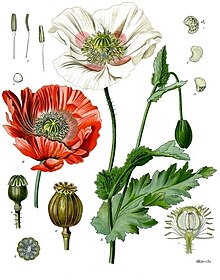| Papaver somniferum | |
|---|---|

| |
| Scientific classification | |
| Kingdom: | Plantae |
| Clade: | Tracheophytes |
| Clade: | Angiosperms |
| Clade: | Eudicots |
| Order: | Ranunculales |
| Family: | Papaveraceae |
| Genus: | Papaver |
| Species: | P. somniferum
|
| Binomial name | |
| Papaver somniferum | |
Papaver somniferum, commonly known as the opium poppy[2] or breadseed poppy,[3] is a species of flowering plant in the family Papaveraceae. It is the species of plant from which both opium and poppy seeds are derived and is also a valuable ornamental plant grown in gardens. Its native range was east of the Mediterranean Sea, but has since been obscured and vastly expanded by introduction and cultivation from ancient times to the present day, being naturalized across much of Europe and Asia.
This poppy is grown as an agricultural crop on a large scale, for one of three primary purposes: to produce poppy seeds, to produce opium (for use mainly by the pharmaceutical industry),[4] and to produce other alkaloids (mainly thebaine and oripavine) that are processed by pharmaceutical companies into drugs such as hydrocodone and oxycodone.[4] Each of these goals has special breeds that are targeted at one of these businesses, and breeding efforts (including biotechnological ones) are continually underway.[4][5][6] A comparatively small amount of P. somniferum is also produced commercially for ornamental purposes.
Today many varieties have been bred that do not produce a significant quantity of opium.[3][5] The cultivar 'Sujata' produces no latex at all.[6] Breadseed poppy is more accurate as a common name today because all varieties of P. somniferum produce edible seeds. This differentiation has strong implications for legal policy surrounding the growing of this plant.[5]
- ^ Linnaeus Cv (1753). Species Plantarum. Vol. 1. Laurentius Salvius. p. 508.
- ^ BSBI List 2007 (xls). Botanical Society of Britain and Ireland. Archived from the original (xls) on 26 June 2015. Retrieved 17 October 2014.
- ^ a b "Breadseed or opium poppy, Papaver somniferum" (PDF). University of Wisconsin Extension, Master Gardener Program. Retrieved 21 November 2020.
- ^ a b c Bradsher K (19 July 2014). "Shake-Up on Opium Island". The New York Times. Retrieved 8 January 2018.
- ^ a b c Gaevskii A (1999). "On the intraspecies classification of opium poppy (Papaver somniferum L.)". Khimiko-Farmatsevticheskii Zhurnal. 33 (3): 32–36. doi:10.1007/BF02508453. S2CID 9716321.
- ^ a b Chaturvedi N (2014). "Latex-less opium poppy: cause for less latex and reduced peduncle strength)" (PDF). Physiologia Plantarum. 150 (3): 436–445. Bibcode:2014PPlan.150..436C. doi:10.1111/ppl.12086. PMID 24033330. Retrieved 7 January 2018.